This post may contain affiliate links. Please see our disclosure policy.
Canning French onion soup is a delicious way to turn a slow-cooked meal into a quick heat-and-eat meal in a jar. By batch-cooking onions all together for canning, you can make many meals at once, saving time later on down the road.
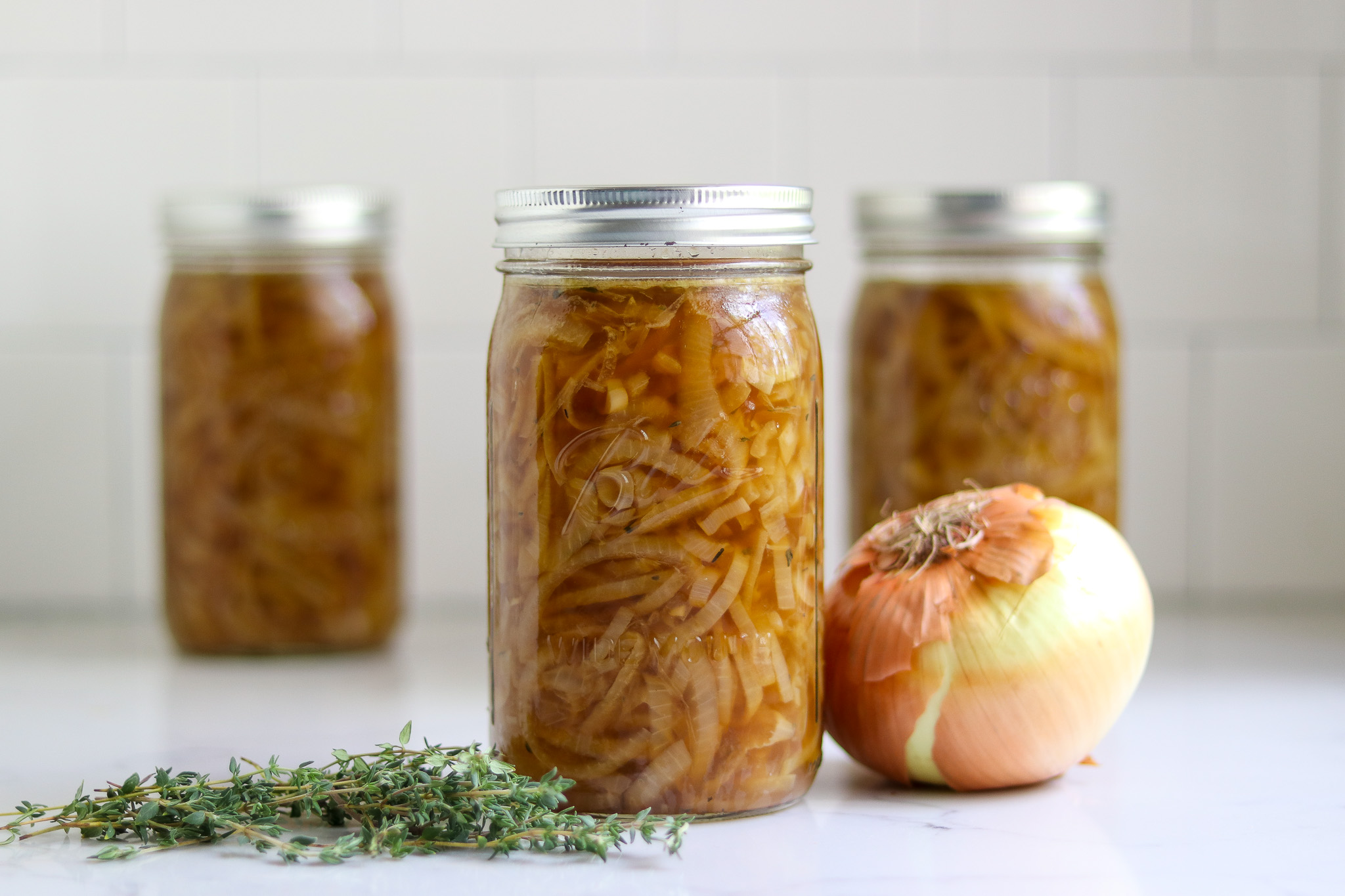
Table of Contents
- Ingredients for French Onion Soup
- Preparing Onions for French Onion Soup
- Making French Onion Soup for Canning
- Altitude Adjustments
- Serving French Onion Soup
- Soup Canning Recipes
- Canning French Onion Soup Recipe
- Altitude Adjustments for Canning French Onion Soup
- For dial gauge pressure canners:
- For weighted gauge pressure canners:
- Meal in a Jar Canning Recipes
French onion soup is one of my favorite comfort food meals, and I absolutely love the savory flavor of the slow-cooked carmelize onions combined with crunchy bread and bubbly melted cheese.
What I don’t love, is standing over the stove for a whole hour just to make a bowl or two.
By canning French onion soup, you can cook once and enjoy French onion soup many times right from your pantry shelf.
It actually gets better in the jar, and the flavors deepen during the canning process, creating an even more savory delight packed with rich umami flavors.
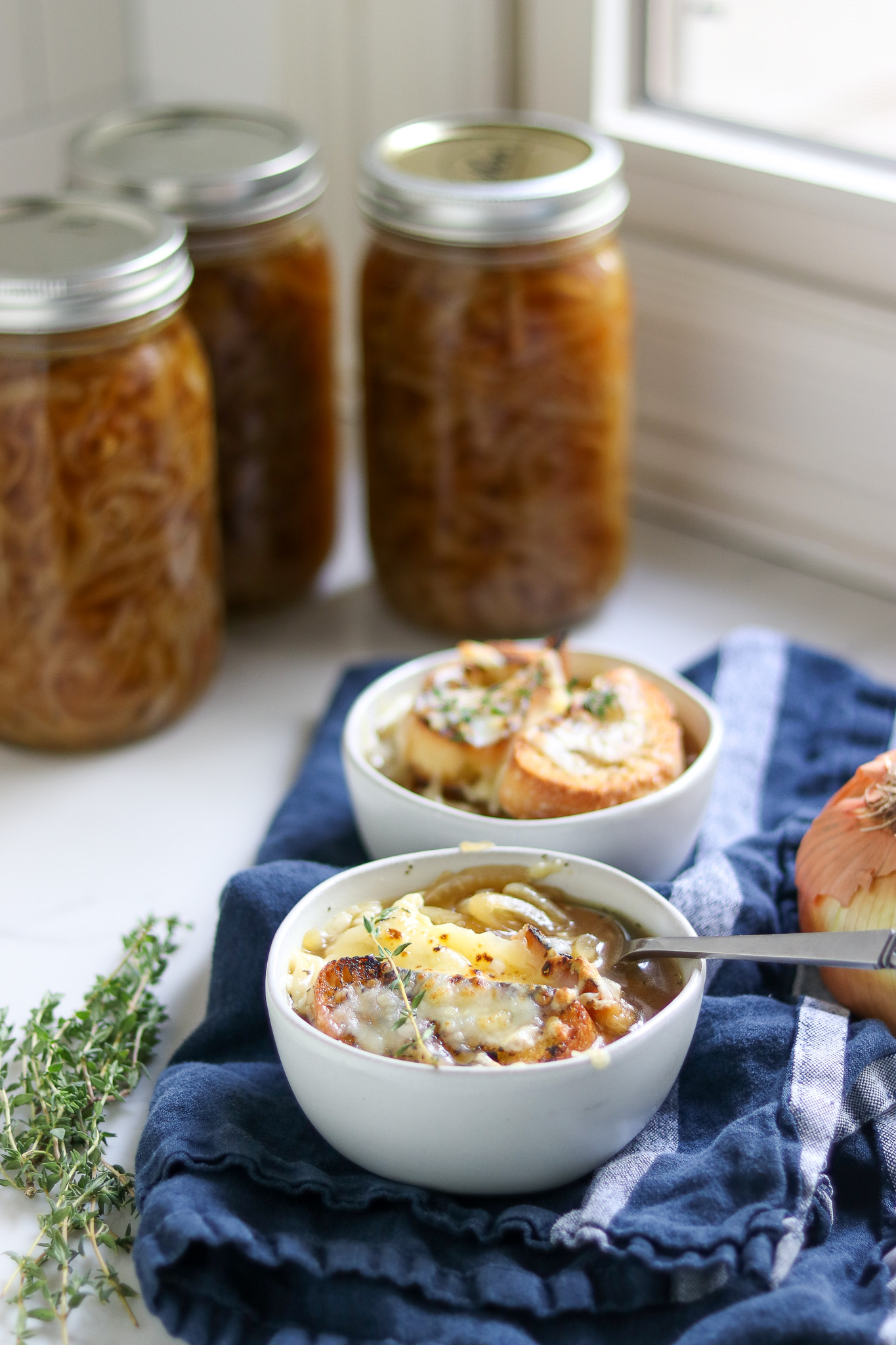
French onion soup is a hearty and delicious soup that’s perfect for cold weather – and let’s face it, it’s a true classic. This dish is a great way to use up all those onions that have gone past their prime, and canning it is an excellent way to preserve its flavors and nutrients for the long term.
I’ve written this recipe for a standard pressure canner batch of 4 quarts, but you can increase the batch size as much as you’d like to fit larger canners. I use a large All-American Pressure Canner, which actually holds 14 wide-mouth quart jars.
Using a mandoline really speeds up the process of slicing the onions, and then I brown them all in a big stock pot before canning.

Ingredients for French Onion Soup
This canning recipe for French onion soup is a tested recipe by Ball Canning. It’s adapted from The All New Ball Book of Canning and Preserving (pg. 290).
The ingredients for canning French onion soup are quite simple. To make a canner batch of eight pints or four quarts, you’ll need the following:
- 1 Tbsp (15 ml) butter
- 3 qt (3 L) beef bone broth or commercial canned beef, chicken, or vegetable stock
- 4 lb (2 kg) onions, thinly sliced
- 1 Tbsp (15 ml) salt
- 1 tsp (5 ml) ground black pepper
- 3 cups (750 ml) dry white wine, divided
- 1 tsp (5 ml) dried thyme
The butter in this recipe is just used to brown the onions, and that small amount is allowed in pressure canning recipes. If you need more fat for browning, try adding a neutral oil or olive oil.
I’m using beef stock here, which is traditional, but vegetable stock will also work for a vegetarian version.
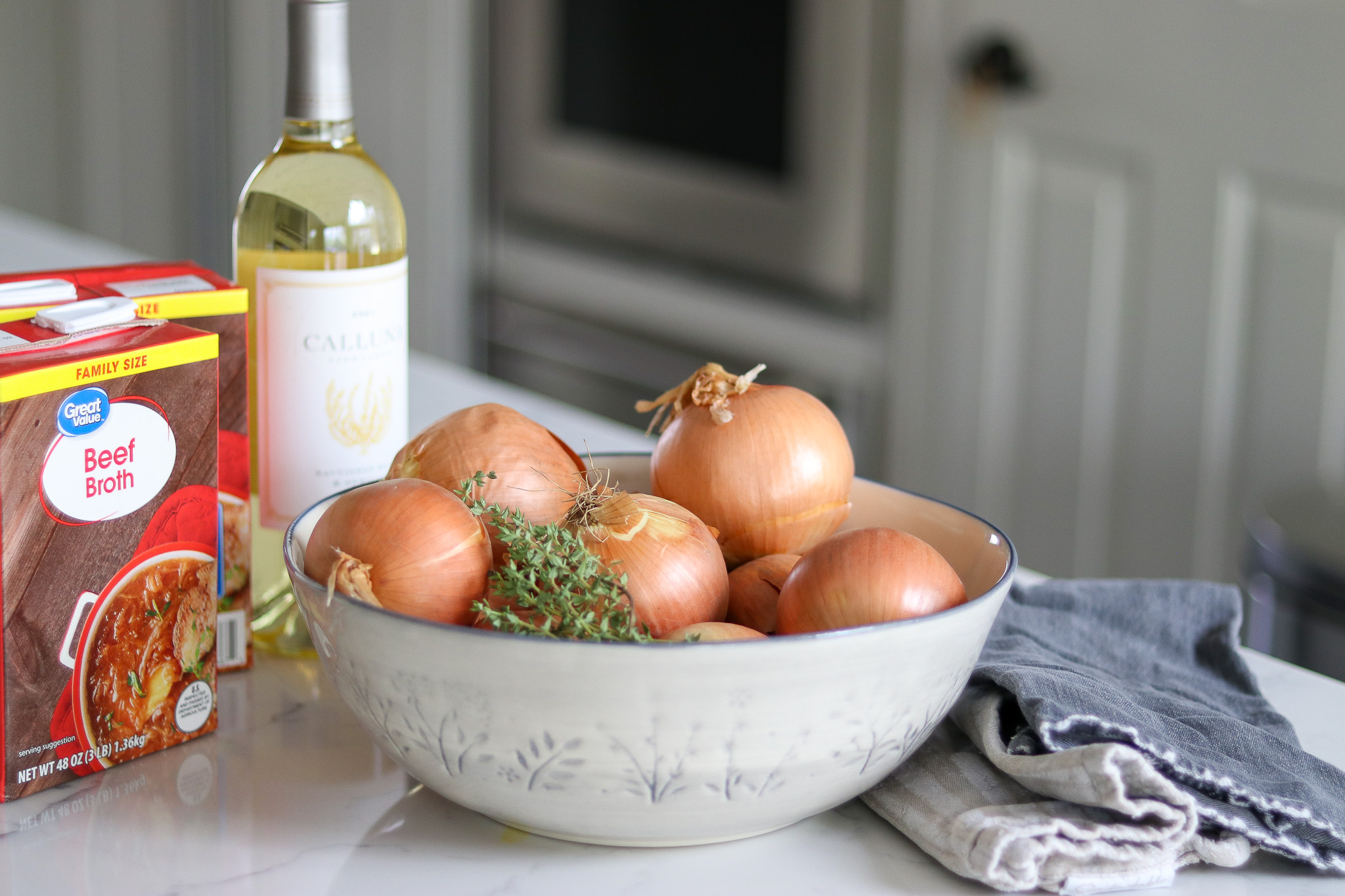
A dry white wine adds amazing flavor to the finished soup, but it’s optional. You can add water or more broth or stock instead.
In terms of spices, thyme is traditional, and it’s simply spiced on purpose. That said, if you’d like you can add other dry spices without impacting canning safety.
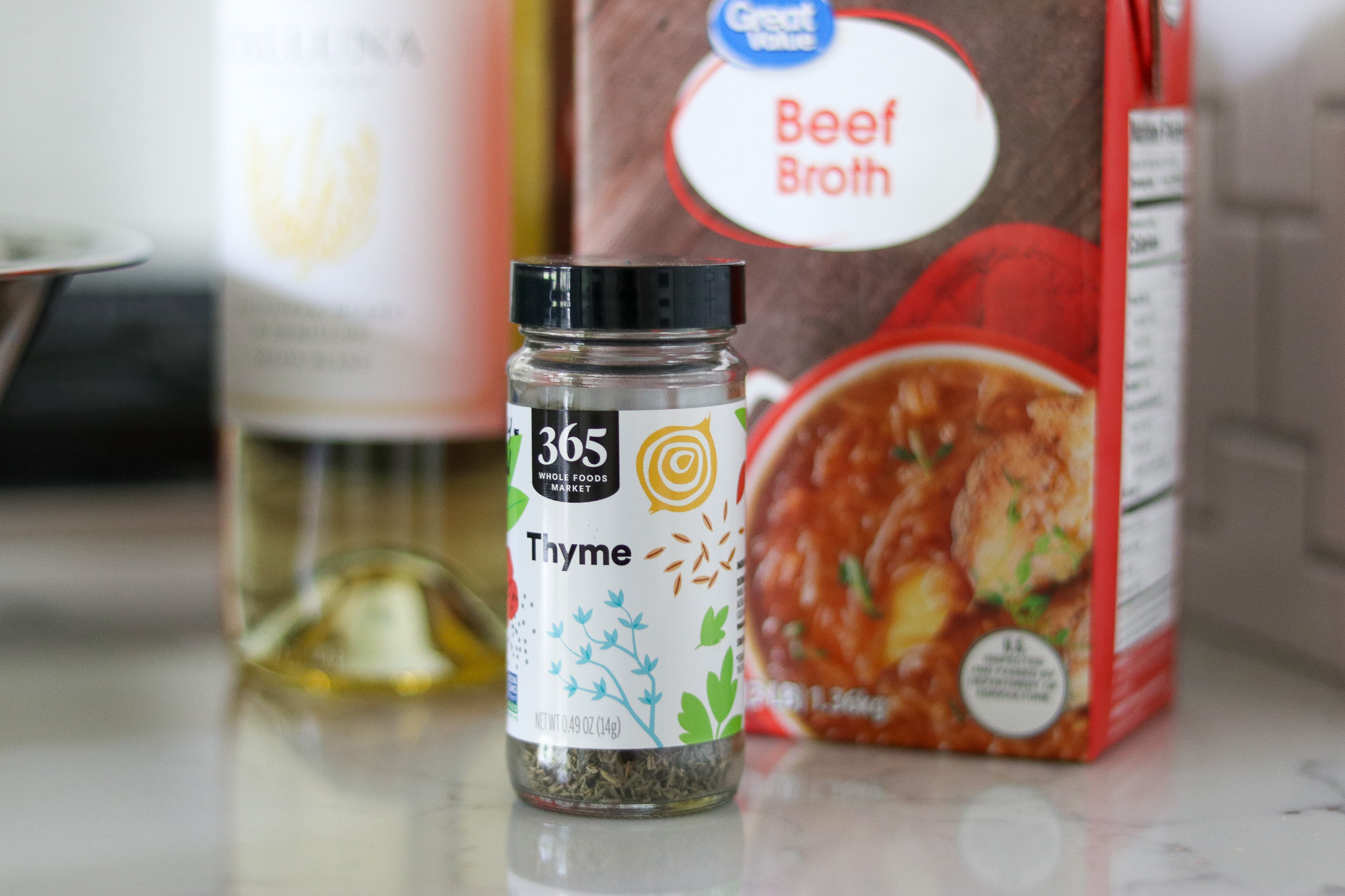
Generally, French onion soup is served with toasted bread and melted cheese on top.
Those ingredients are added at serving, and they’re delicious but optional. You can just heat and eat the soup right out of the jar.
Just be sure you don’t add bread or cheese to the jar when canning. It won’t be tasty, and neither are approved for canning.
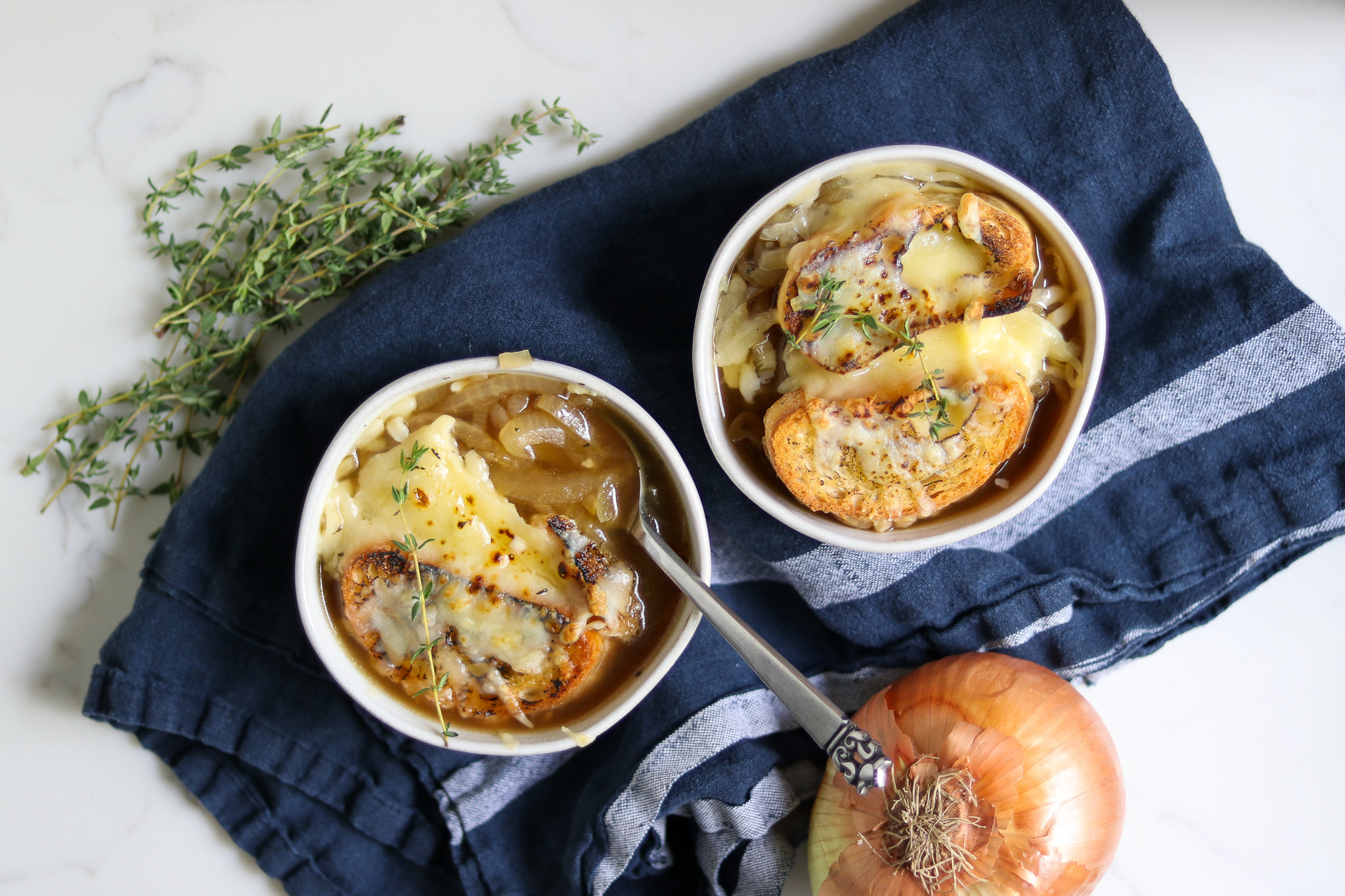
Preparing Onions for French Onion Soup
The key to making a really high-quality French onion soup is finely sliced onions that are a consistent size. When they’re all different sizes the soup suffers a bit, because they don’t cook or brown evenly, and it can change the mouthfeel.
That’s a fussy french thing, and really, you can just chop them and be done with it. But know that your soup will be better if you slice them finely.
A mandoline slicer really helps with this, and makes the job take just minutes (and the faster you do it, the less tears, of course).
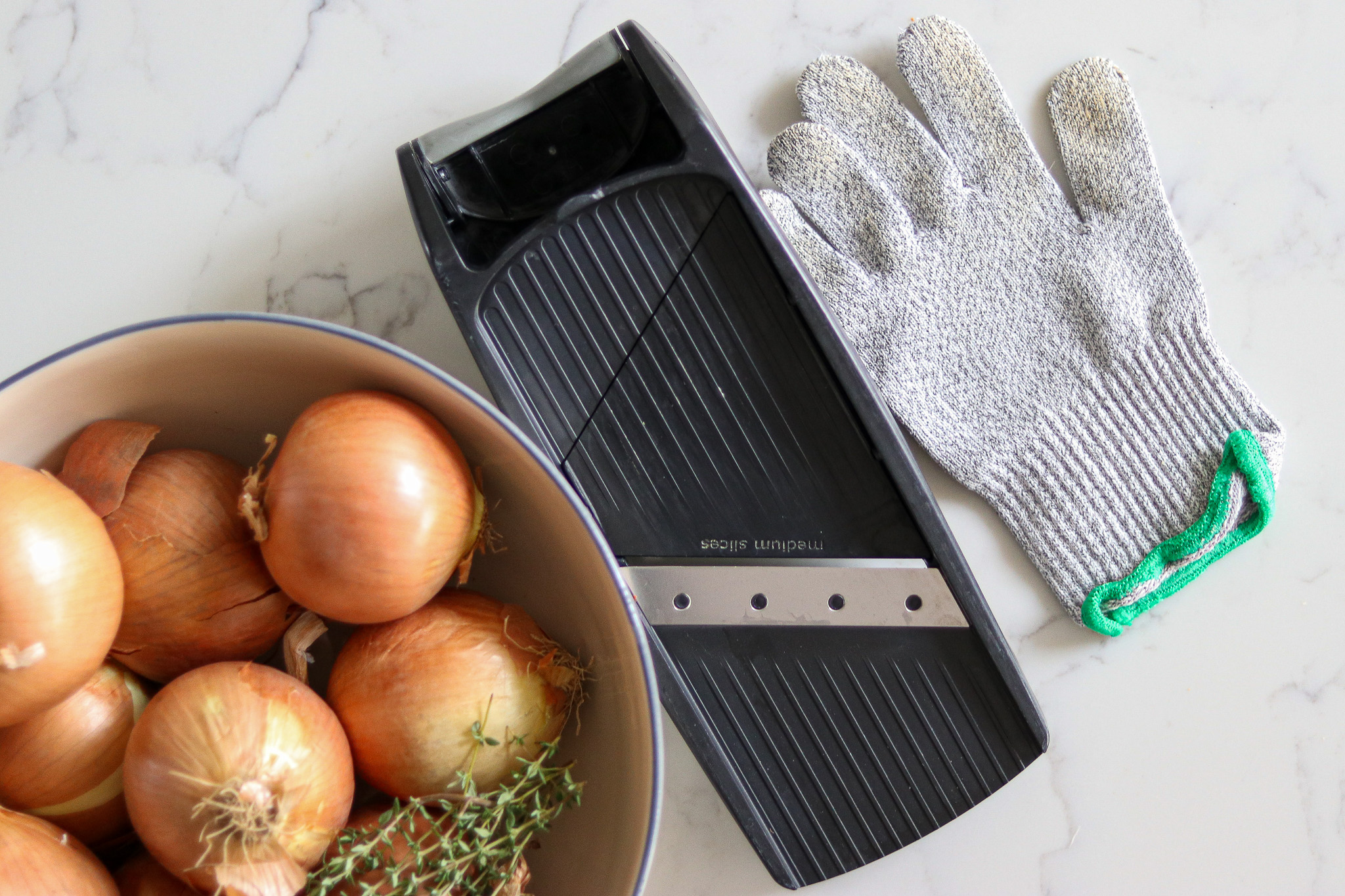
Before slicing the onions, chop off both ends and peel them carefully.
The onion ends and peels can be saved for making a savory onion stock, which you can either use in this soup or save for another purpose. (Or you can just compost them.)
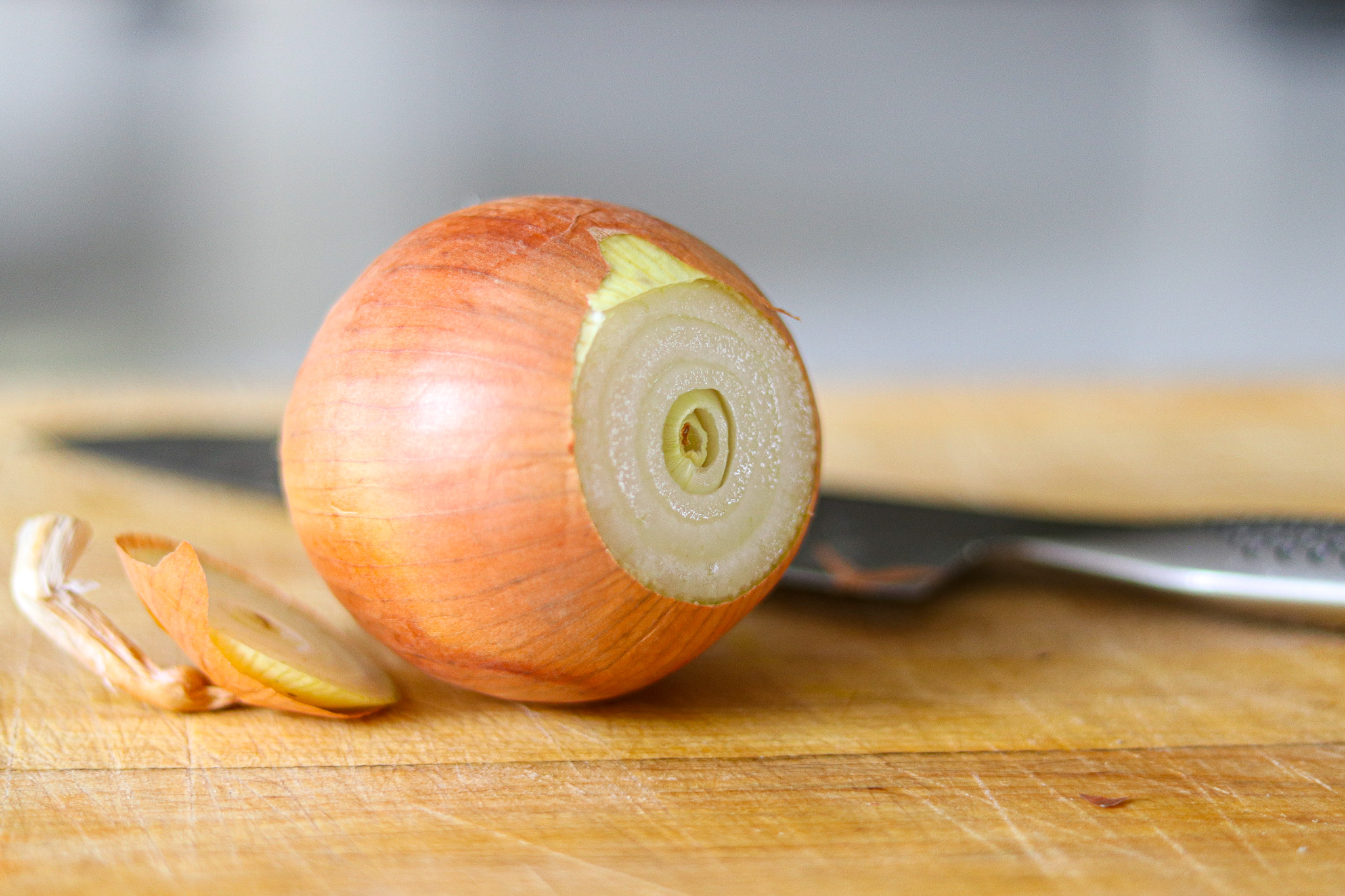
The onions for this recipe are weighed whole as purchased. Four pounds works out to about 12 large onions, or about 20 medium ones. It’s quite a few onions.
You can work in batches, slicing them by hand, or again, it’s will take just 2-3 minutes to slice them all evenly if you use a mandoline.
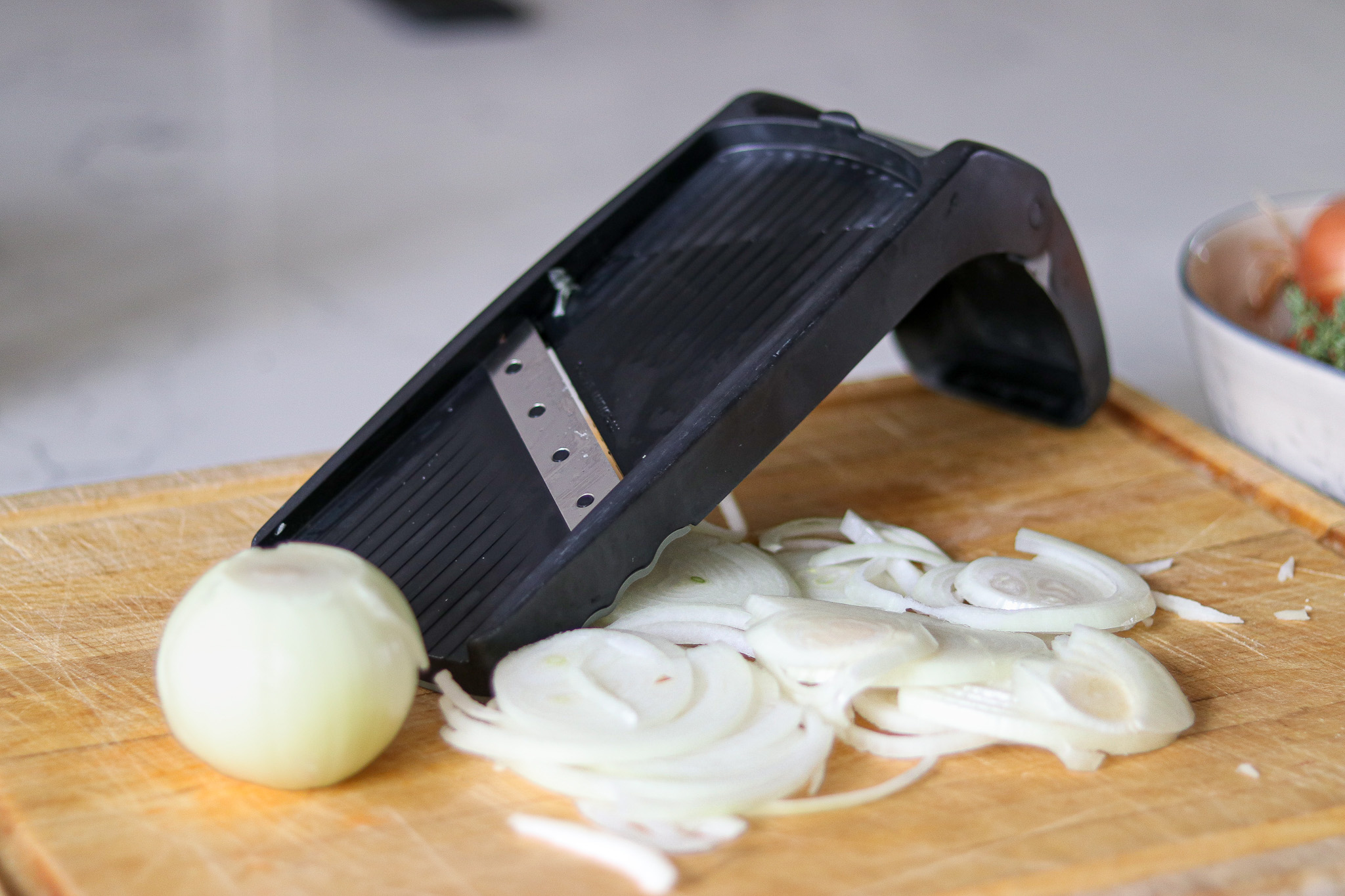
Once the onions are peeled and thinly sliced, it’s time to start cooking.
Assemble all the ingredients listed, but don’t start preheating your canner yet. You’ll need to cook the soup for about an hour before the canning process starts.
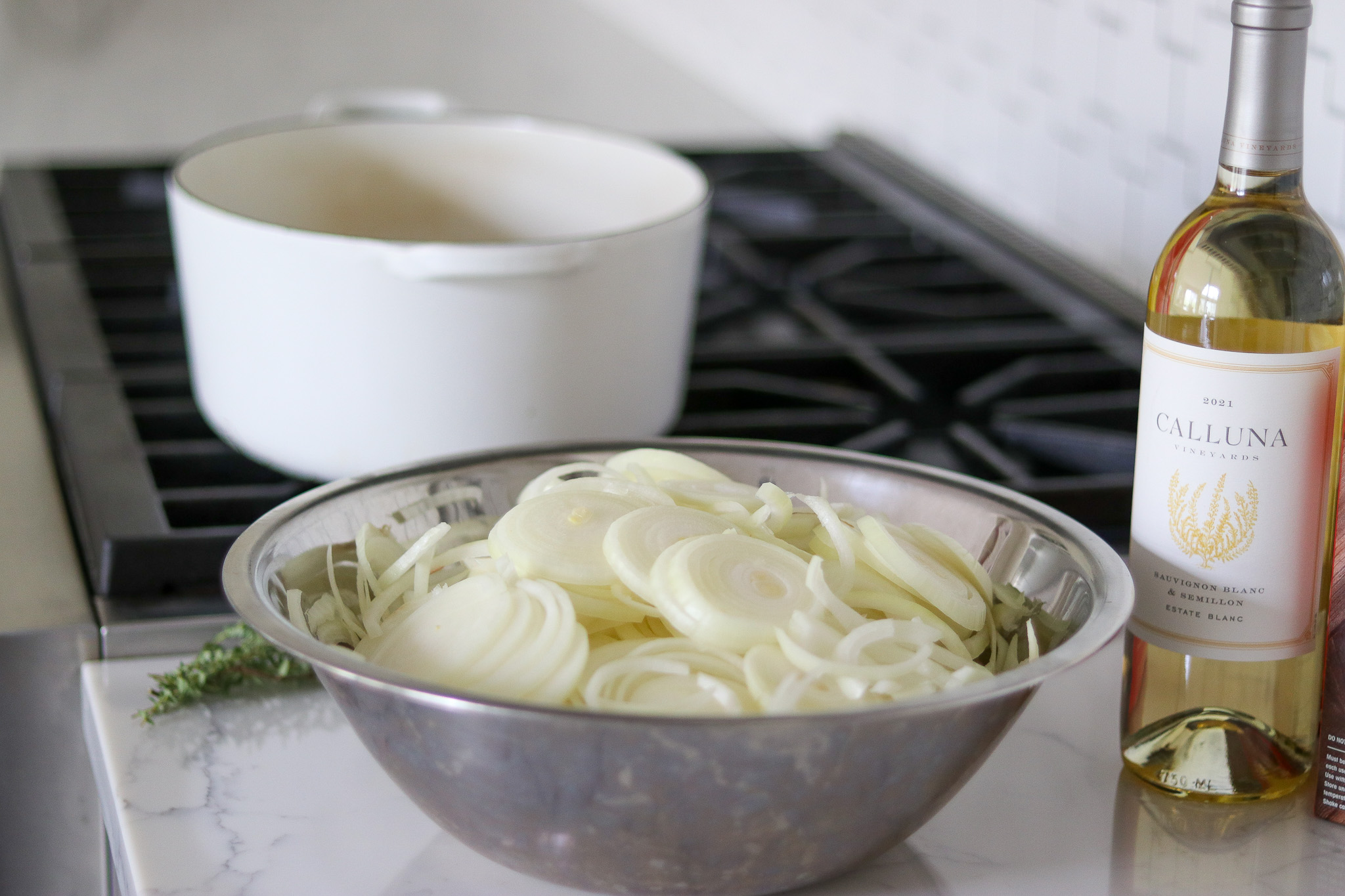
Making French Onion Soup for Canning
Begin by melting the butter in a stainless steel or enameled Dutch oven, cooking over medium-low heat. Stir in the onion, along with the salt, black pepper, and thyme, along with 2 cups of white wine (put the other cup off to the side for later).
The wine added at the start helps the onions soften quickly, but it’ll quickly evaporate. The leaves behind a bit of sugar, which will help the onions brown and caramelize.
(If you’re not using wine, you can use water or stock here. Adding 1 tsp sugar will help the onions brown, but it’s optional.)
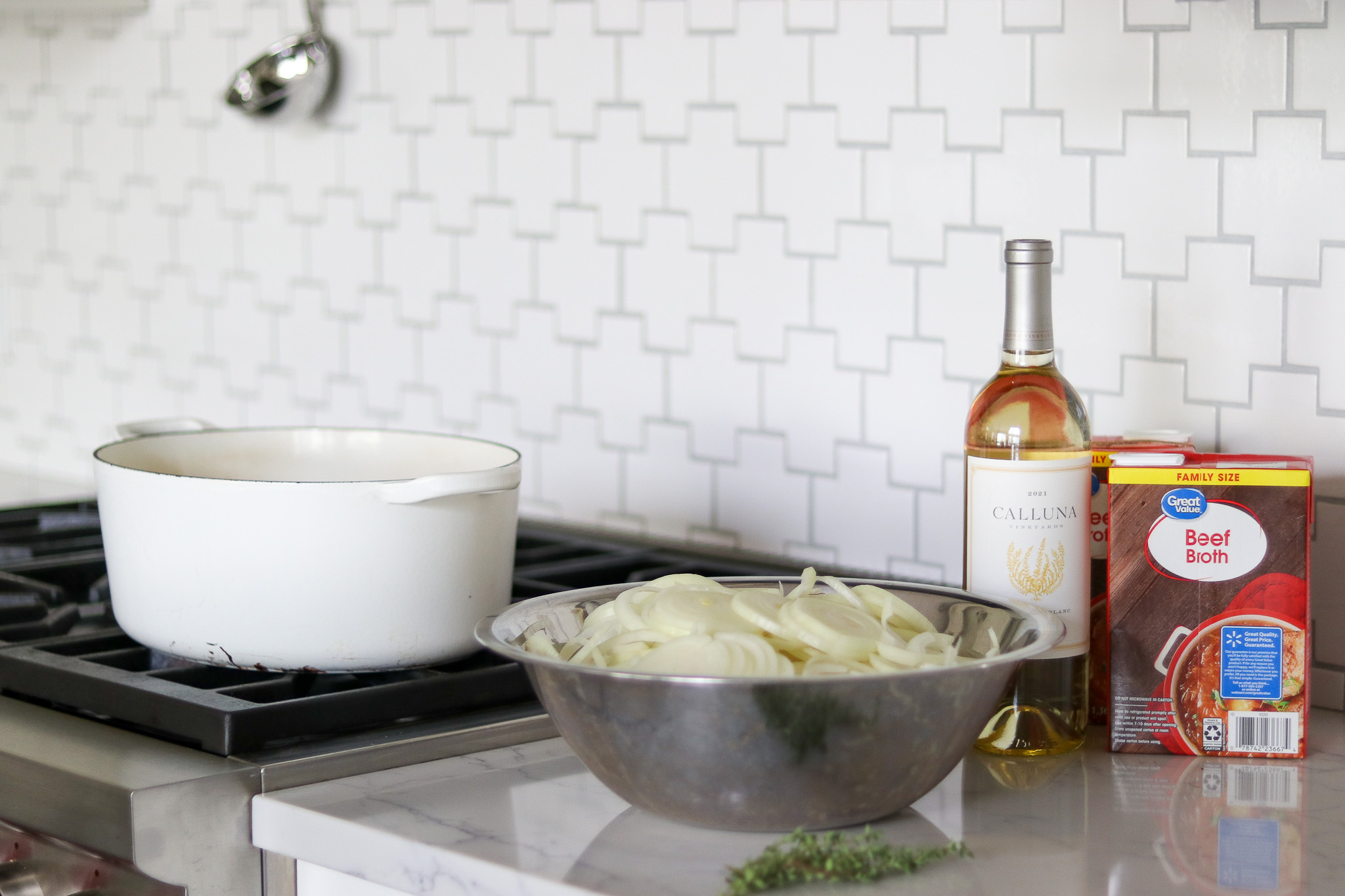
Cover the mixture and cook for an hour, or until the onion is tender. Stir often to prevent burning.
Leaving the lid on the pot here helps them cook more slowly, and I’d reccomend it.
As I said, the wine will evaporate quickly, so you’re really just using it at the start to soften the onions and help them brown without burning. Most of the process is a sautee where the onions are browning, and you’ll need to stir frequently to prevent burning.
Toward the end of the 1 hour cook, prepare a pressure canner, jars and lids.
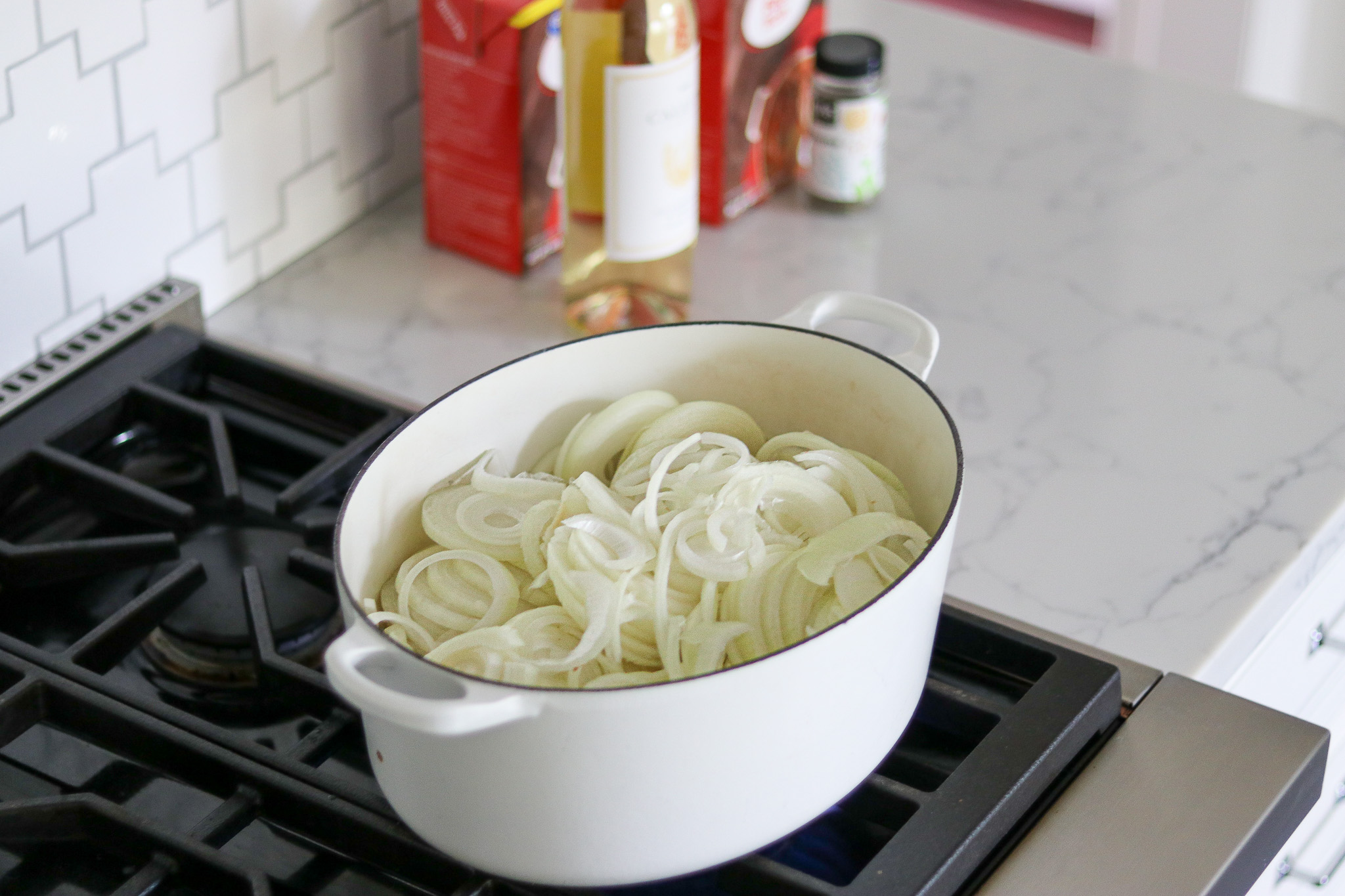
Uncover the pot and cook at a higher heat until the onion is caramelized.
Add the rest of the white wine, then cook for an additional two minutes. Make sure you loosen any browned bits from the bottom of the Dutch oven.
Stir in the broth, then bring to a boil.
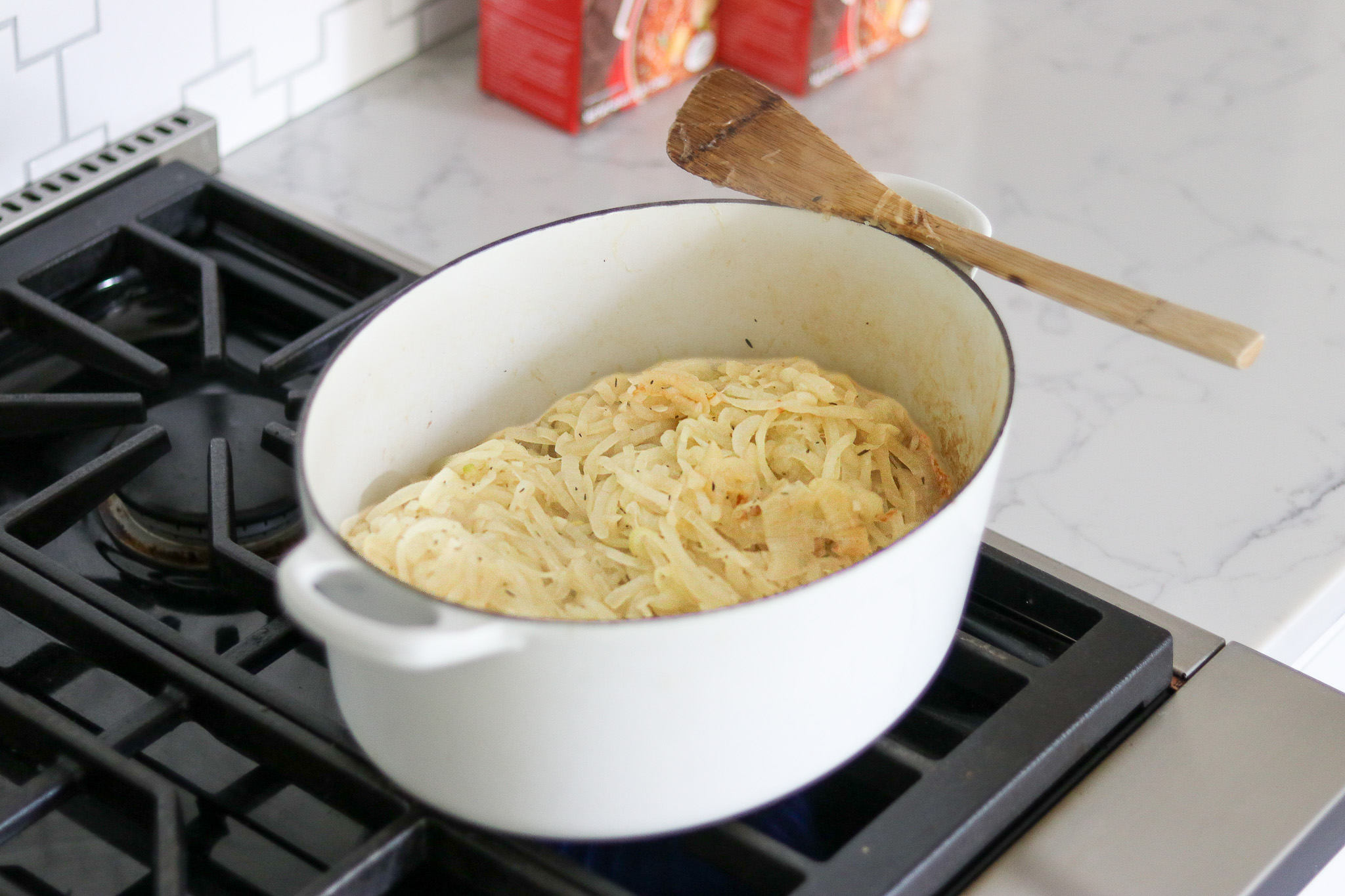
Reduce the heat, then simmer, uncovered, for 15 minutes.
This additional simmer times helps bring all the flavors together, but really, the main point is to ensure that everything’s evenly heated before it goes into canning jars.
After this simmer time, the soup is “done,” and you can taste it and adjust seasonings to taste before canning.
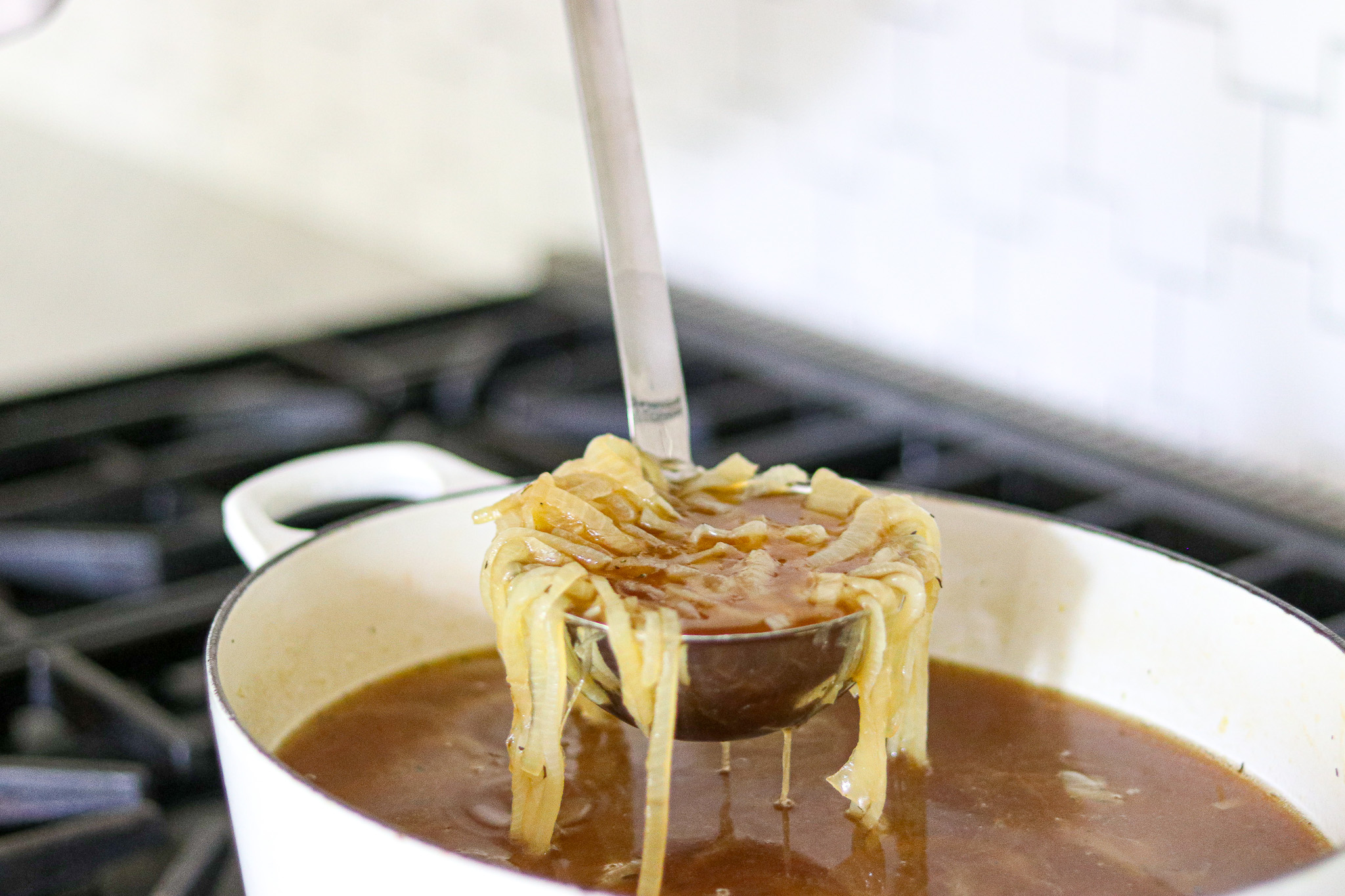
Toward the end of the 1-hour pre-cook for the onions, you should prepare your pressure canner, jars, lids and rings. While you finish browning the onions and bringing the soup to a simmer, the canner should be pre-heating to just simmering (about 180 degrees F).
When the soup is done, ladle it into hot jars. Leave an inch (2.5 cm) of headspace.
Remove air bubbles and wipe any food residue or liquid from the rims of the jars. Place the lids on the jars, then apply bands and adjust until they are fingertip-tight.
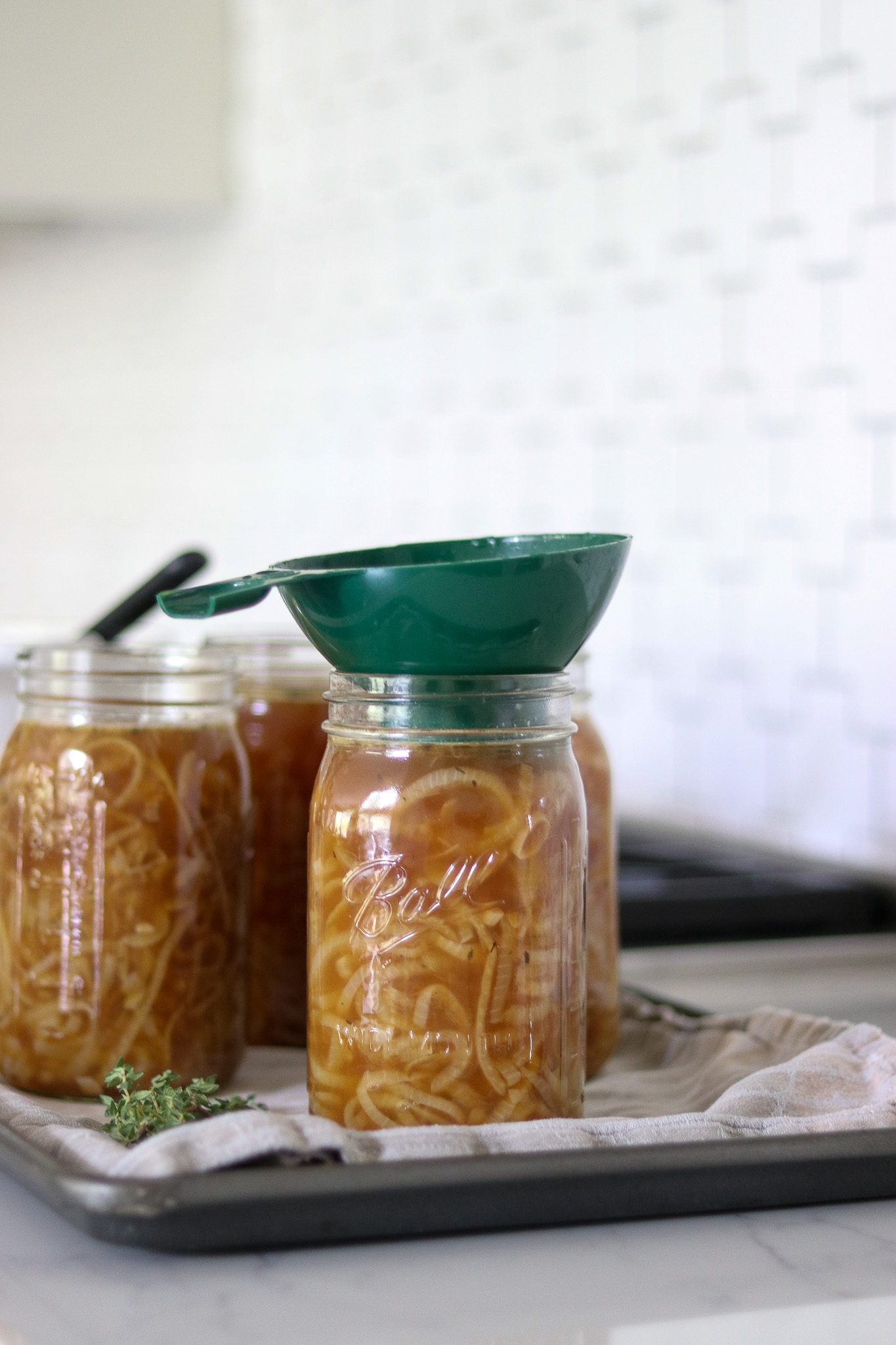
Put the jars on the rack inside your pressure canner. There should already be 2-3 inches of simmering water in the prepared pressure canner.
Put the lid on the canner, then turn it to the locked position.
Turn the heat on medium-high, then vent steam for 10 minutes.
Put the counterweight or weighted gauge on the vent, then bring the pressure to 10 lbs for a weighted gauge canner or 11 lbs for a dial-gauge canner.
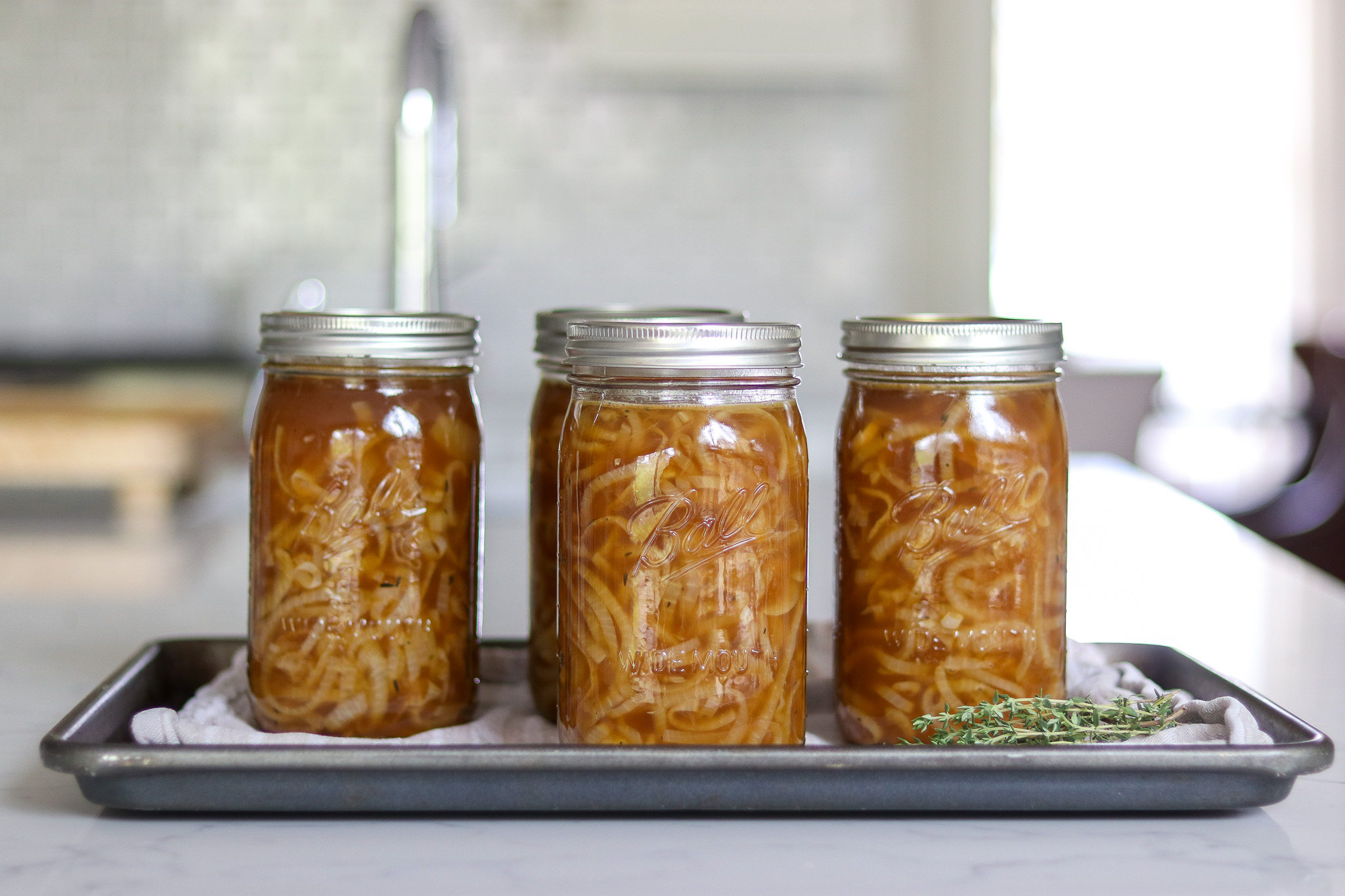
Process pint jars for 60 minutes or quart jars for 75 minutes. Turn off the heat, then cool the canner to zero pressure. Let the jars cool for another five minutes after you’ve removed the canning weight before you remove the lid.
Cool the jars in the canner for another ten to fifteen minutes, then put them out to cool at room temperature.
Label the jars, check the seals, and store.
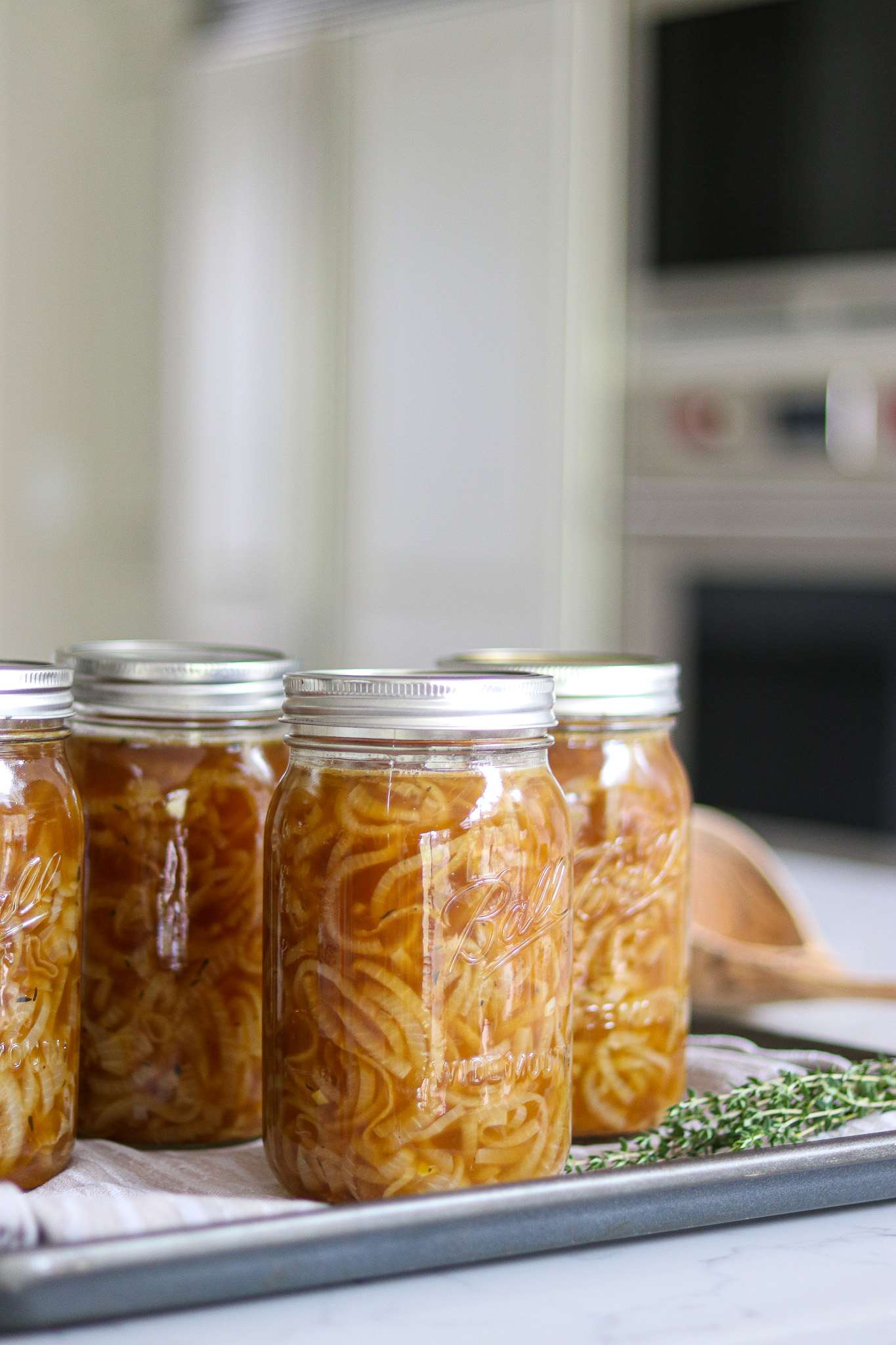
Altitude Adjustments
With pressure canning, the processing times stay the same at higher altitudes, but the pressures change. Here are the altitude adjustments for pressure canning:
For dial gauge pressure canners:
- 0 to 2,000 feet in elevation – 11 lbs pressure
- 2,001 to 4,000 feet in elevation – 12 lbs pressure
- 4,001 to 6,000 feet in elevation – 13 lbs pressure
- 6,001 to 8,000 feet in elevation – 14 lbs pressure
For weighted gauge pressure canners:
- Above 1,000 feet – 15 lbs pressure
- 0 to 1,000 feet in elevation – 10 lbs pressure
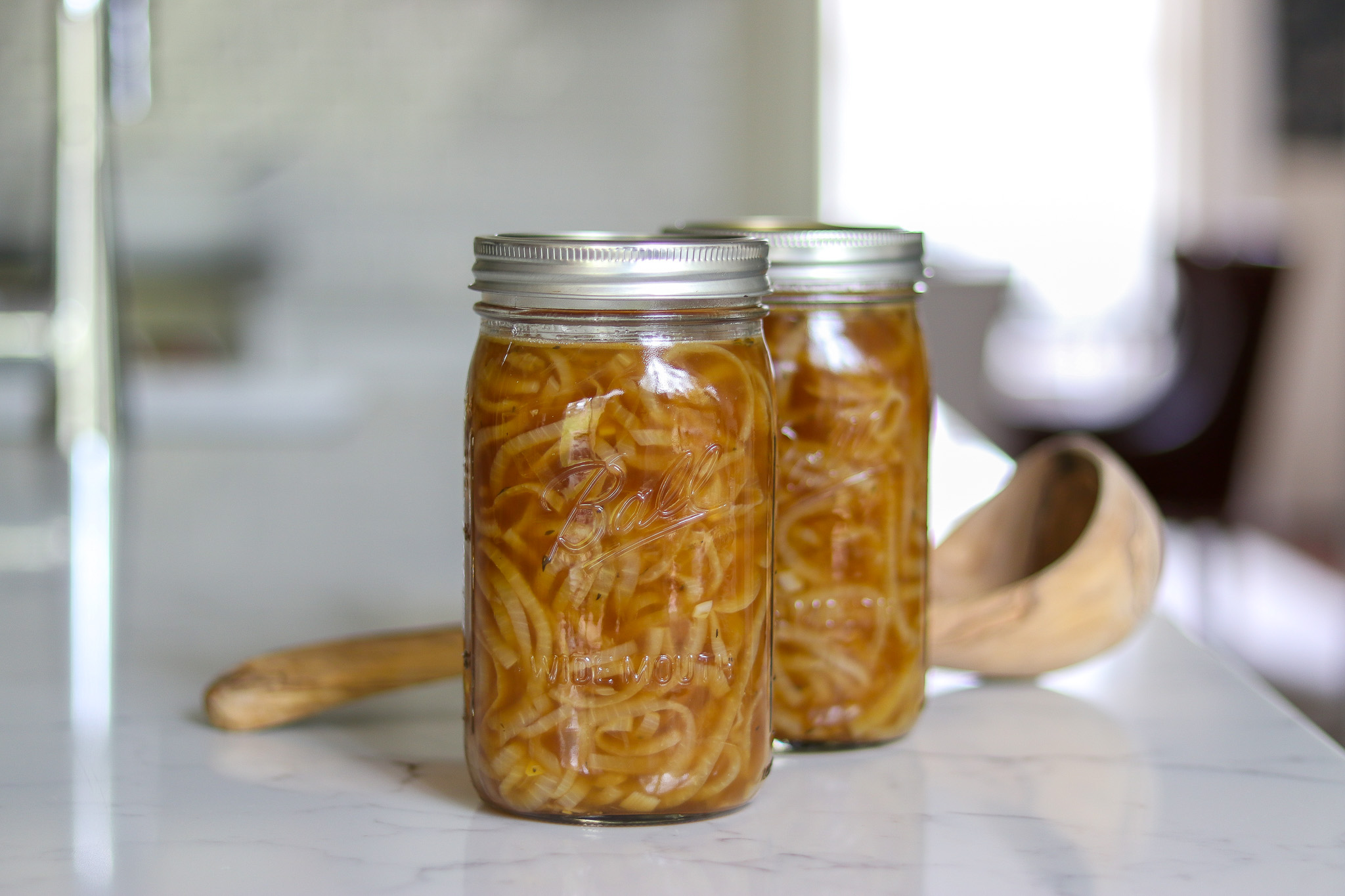
Serving French Onion Soup
Ready to eat?
One of the great things about canned French onion soup is that it’s so versatile. You can adapt the recipe to suit your tastes and dietary preferences, whether you prefer a vegetarian version, gluten-free version, or one with different types of cheese.
You can also use it as a base for other recipes, such as casseroles, stews, and pot pies.
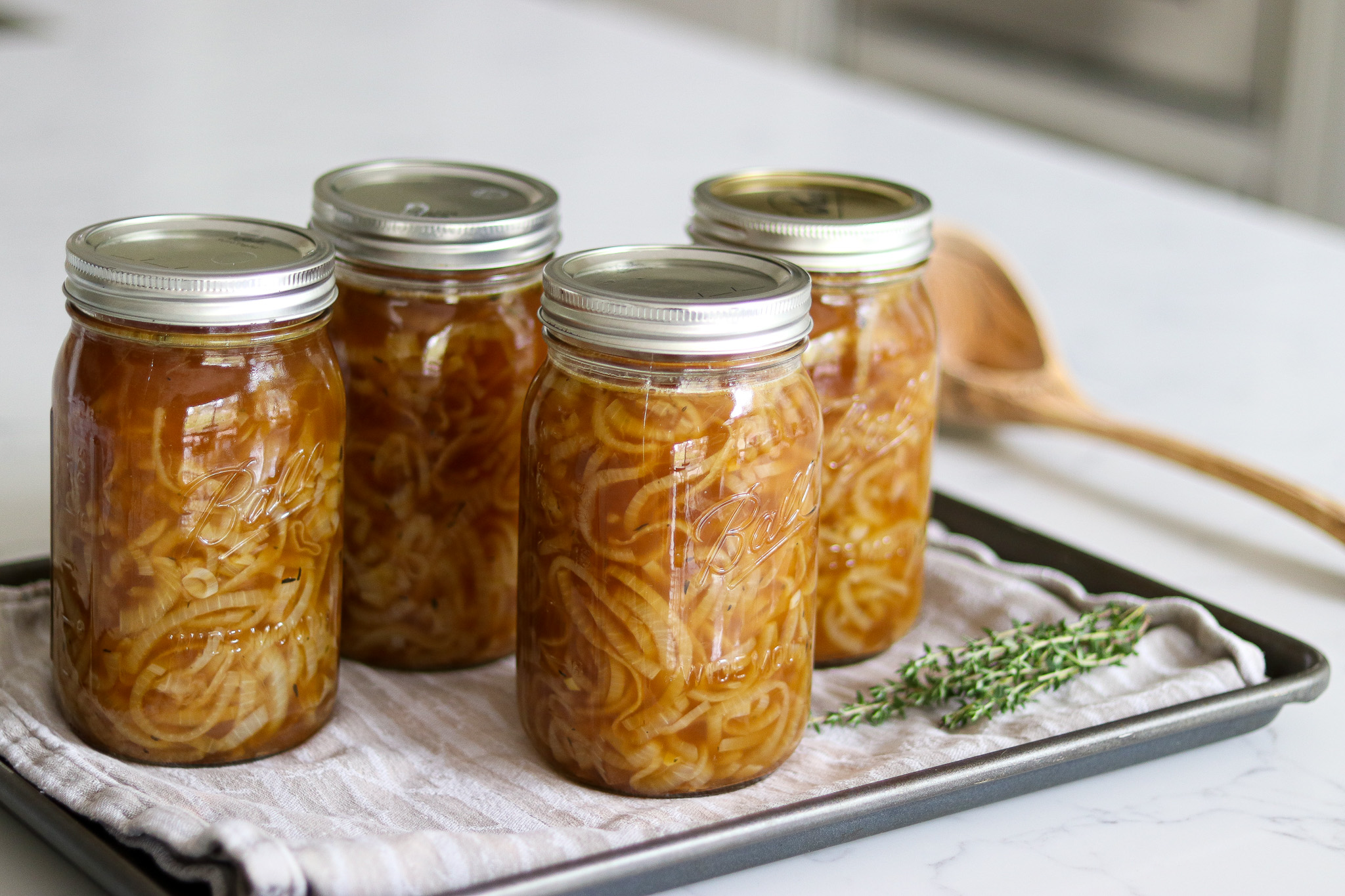
When it’s time to enjoy your homemade French onion soup, all you need to do is open a jar and transfer it into a small saucepan. Bring it to a simmer for 10 minutes to heat it all the way through, then broil a sliced baguette covered in Gruyere and Swiss cheese. Place this on top of the soup, then sprinkle with fresh sprigs of thyme.
Bon appetit!
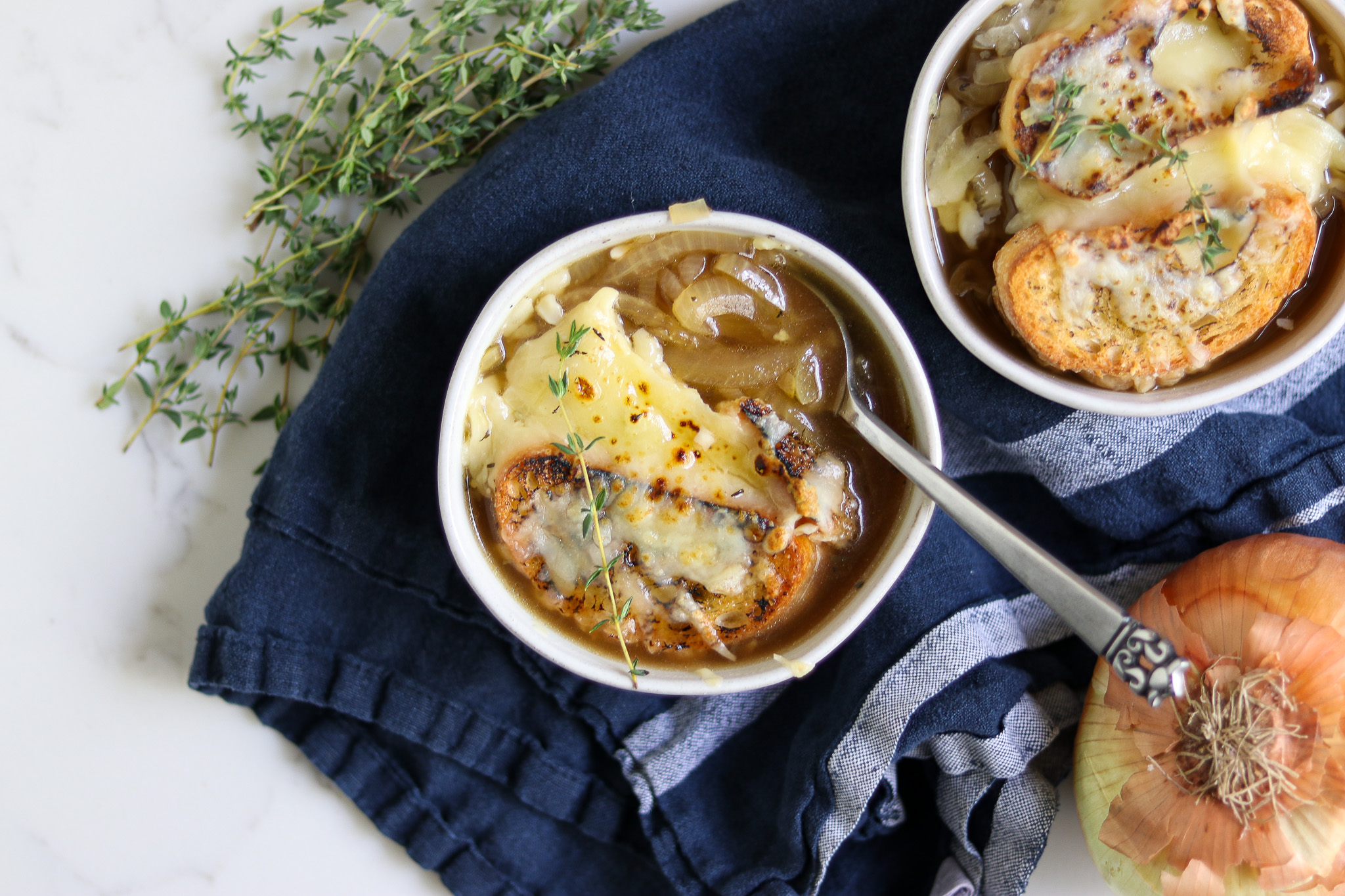
Instead of serving French onion soup as it is, you can also incorporate it into other meals.
All you have here is basically carmelized onions in a rich, beefy umami stock that’s perfect for cooking pot roasts or adding as the base for other dishes.
Get creative, and add it anywhere you’d add onions and stock.
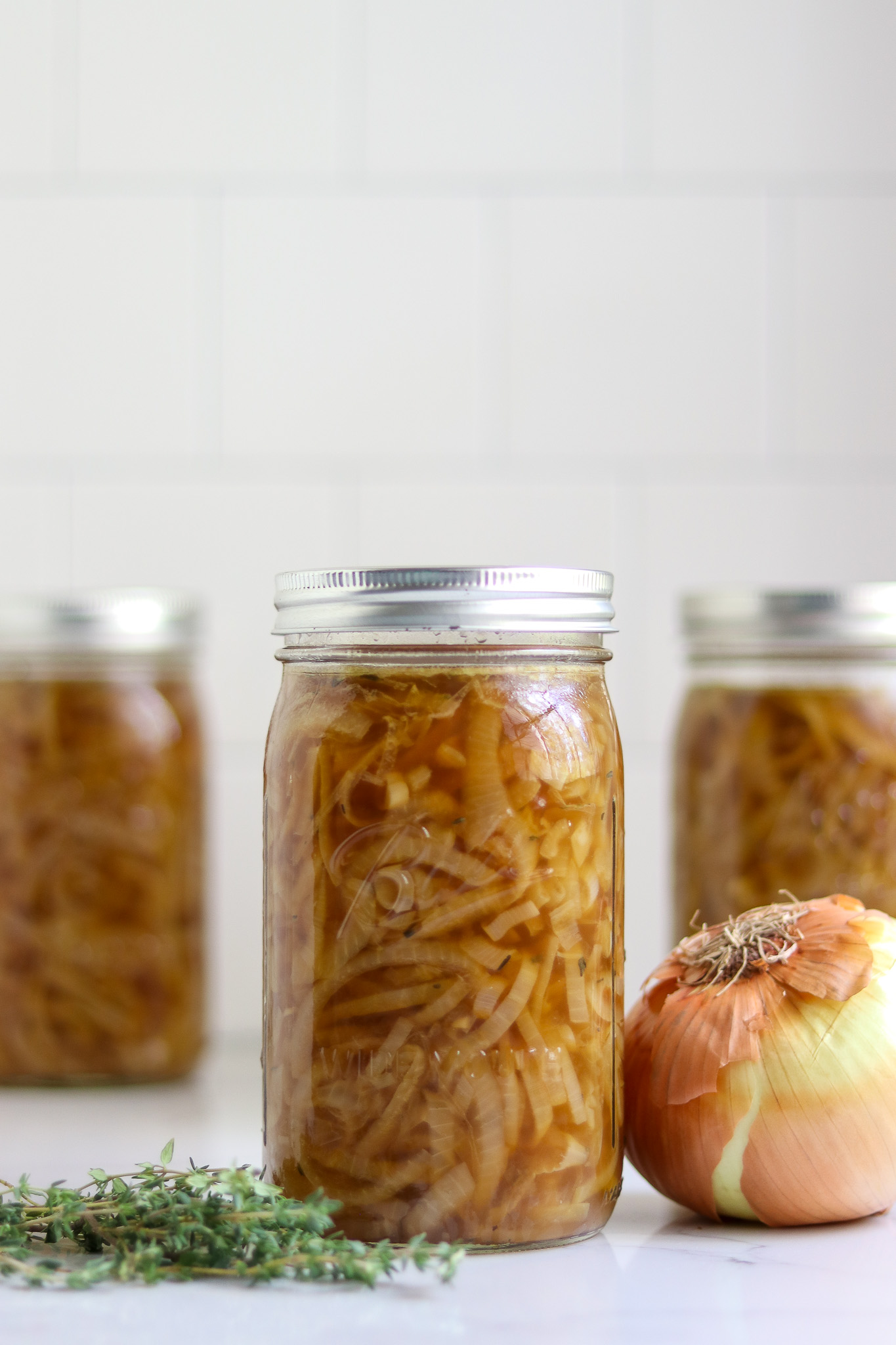
Soup Canning Recipes
There are so many different soup canning recipes out there, try these for your pantry:
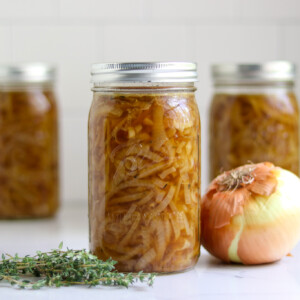
Canning French Onion Soup
Equipment
Ingredients
- 1 Tbsp Butter
- 3 Quart Beef Broth, beef bone broth or commercial canned beef, chicken, or vegetable stock
- 4 lb onions, thinly sliced
- 1 Tbsp salt
- 1 tsp ground black pepper
- 3 cups dry white wine, divided
- 1 tsp dried thyme
Instructions
- Melt the butter in a stainless steel or enameled Dutch oven, cooking over medium-low heat.
- Stir in the onion, along with the salt, black pepper, and thyme, along with 2 cups of the white wine.
- Cover the mixture and cook for an hour, or until the onion is tender. Stir often to prevent burning.
- Toward the end of this cooking time, prepare a pressure canner by adding a few inches of water to the bottom and bringing it up to a simmer. Also prepare jars, lids and rings.
- Uncover the pot and cook at a higher heat until the onion is caramelized. Add the rest of the white wine, then cook for an additional two minutes. Make sure you loosen any browned bits from the bottom of the Dutch oven.
- Stir in the broth, then bring to a boil.
- Reduce the heat, then simmer, uncovered, for 15 minutes.
- Ladle the soup into hot jars. Leave an inch (2.5 cm) of headspace.
- Remove air bubbles and wipe any food residue or liquid from the rims of the jars.
- Place the lids on the jars, then apply bands and adjust until they are fingertip-tight.
- Put the jars on the rack inside your simmering pressure canner.
- Put the lid on the canner, then turn it to the locked position. Turn the heat on medium-high, then vent steam for 10 minutes.
- Put the counterweight or weighted gauge on the vent, then bring the pressure to 10 lbs for a weighted gauge canner or 11 lbs for a dial-gauge canner. (Adjust canning weight for altitude, see notes)
- Process pint jars for 60 minutes or quart jars for 75 minutes. Turn off the heat, then cool the canner to zero pressure.
- Let the jars cool for another five minutes after depressurizing before you remove the lid.
- Cool the jars in the canner for another ten to fifteen minutes, then put them out to cool at room temperature.
- Label the jars, check the seals, and store.
Notes
Altitude Adjustments for Canning French Onion Soup
With pressure canning, the processing times stay the same at higher altitudes, but the pressures change. Here are the altitude adjustments for pressure canning:For dial gauge pressure canners:
- 0 to 2,000 feet in elevation – 11 lbs pressure
- 2,001 to 4,000 feet in elevation – 12 lbs pressure
- 4,001 to 6,000 feet in elevation – 13 lbs pressure
- 6,001 to 8,000 feet in elevation – 14 lbs pressure
For weighted gauge pressure canners:
- 0 to 1,000 feet in elevation – 10 lbs pressure
- Above 1,000 feet – 15 lbs pressure
Nutrition
Nutrition information is automatically calculated, so should only be used as an approximation.
Meal in a Jar Canning Recipes
Need a few more meal-in-a-jar canning recipes?
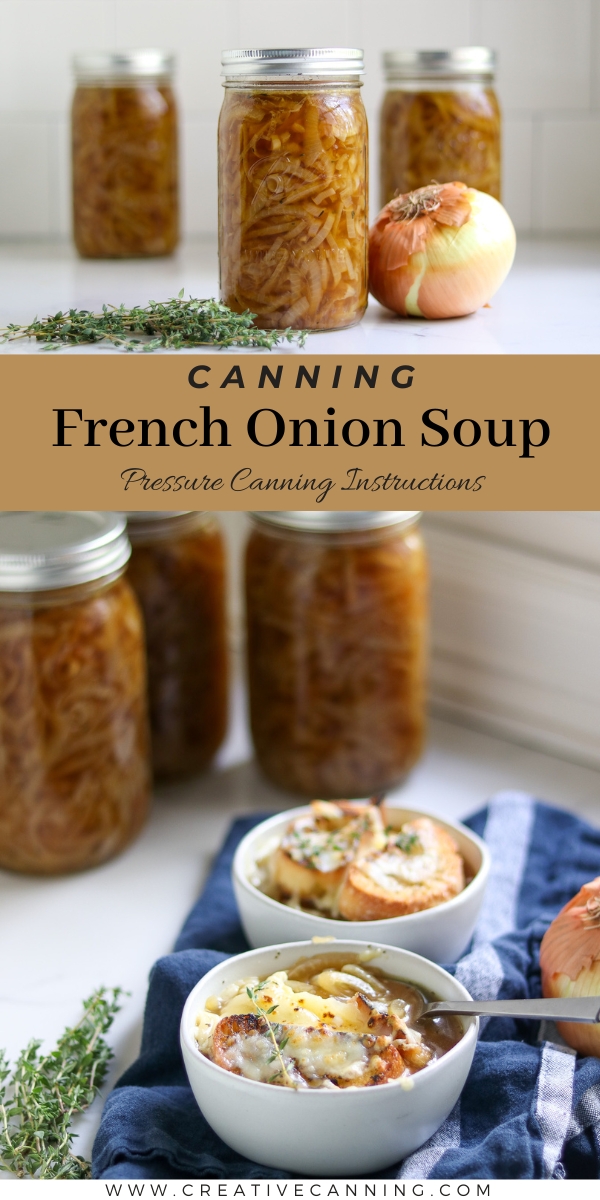
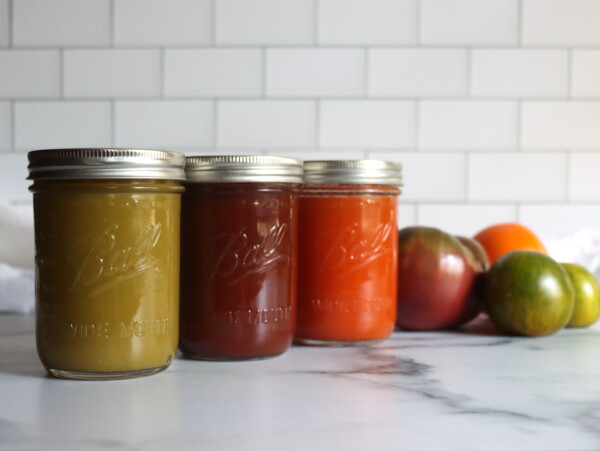
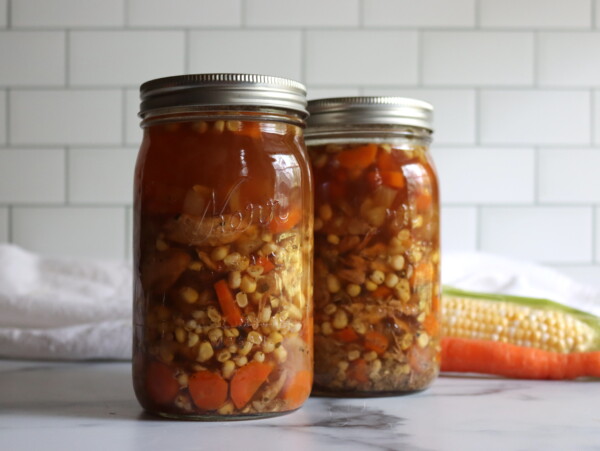
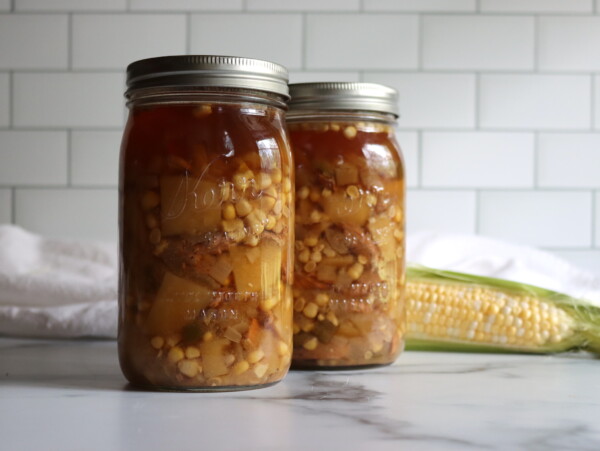
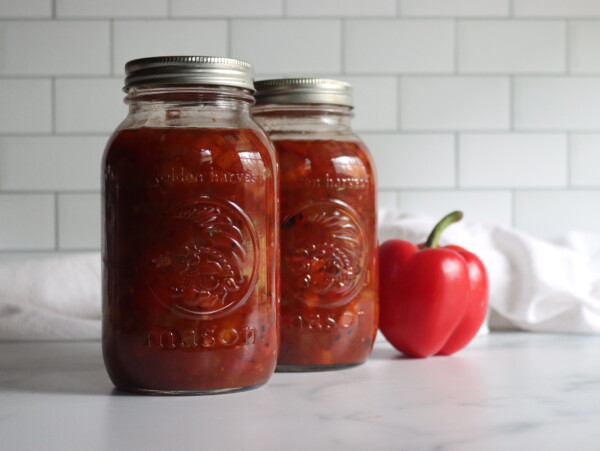
Hi Amy! I’ve got my canner processing your French Onion soup now. I’m excited to have such convenient jars sitting on my shelf. Thank you.
My question is about the onions. Do you weigh them before or after peeling and slicing? I weighed before and found I had less jars to fill, so I added dehydrated onions and some scalloped squash to get a canner full of jars. I wonder if it’s better to weigh them after preparing them.
The 4 lbs is as purchased, as this recipe from Ball Canning assumes you are making a brothy soup that has a lot of liquid (to soak into that classic french onion bread). Generally, summer squash isn’t recommended for canning due to safety reasons, as it can fall apart and make a thick puck in the jars (doesn’t always, but can).
Just made this today and it’s cooling in the canner now. I had a small bowl extra and it is very tasty. I wasn’t sure about the method you suggested for cooking the onions – usually when I make onion soup I caramelize the onions before adding any kind of liquid – but I followed your steps. The flavour of the onions was great because of the wine but the colour wasn’t as deep and rich as I am used to. I think next time I might caramelize as I usually do but add a splash of wine for flavour without it swimming in it. And then add the full amount of wine at the end like you suggest for the reserved 1 cup and let it simmer off before adding the beef broth. Either way the flavour is good and I’m sure it’ll be amazing out of the jar too. Thanks for the canning instructions.
Glad you enjoyed it. Those instructions are what Ball Canning suggests, but yes, I also generally caramelize the onions fully when I’m making French Onion Soup. I have noticed though, I often find that the onions caramelize in the pressure canner, especially if your canner gets a little hotter than is strictly required for preservation.
I’m not much of a drinker and when I search for “dry white wine” there are so many options, one I know is sweet (which doesn’t sound right for this recipe). Do you have any recommendations?
These types are all generally good choices: Pinot Grigio, Pinot Gris, Sauvignon Blanc or Pinot Blanc.
Thank you.
Hey Ashley, do you think substituting the white wine with a dark stout? We find it gives a really good flavor but not sure if it’s safe for canning.
Thanks.
Yup, that’s perfectly fine for canning. Sounds delicious!
My home canned onion soup has a black residue on the lid when I open it. I threw it out since it looked like mold but the jars were sealed. Do you have a possible explanation?
That’s actually normal. Bits of food splash up to the inside of the lid, and then they darken since they’re not under the liquid line. You’ll have that on the lid of a lot of pressure canning batches.
It’s called pinholing. Normal and safe!
Can you use a water bath canner for this recipe?
No, this is not safe for water bath canning. It must be done in a pressure canner.
Hello. This sounds like a lovely recipe. I have made French Onion Soup for many years but from memory. I now own a Nesco Electric Pressure canner and am trying to learn the ins and outs of home canning. I would ask that you help me adapt your recipe and time to this type of canner.
My British husband ( to a Canadian wife ) enjoys Marmite and I have incorporated it into my recipe but don’t know whether it is “cannable”. It is rather like Bovril but an expert opinion would be appreciated.
With a Nesco, you use the same instructions for regular pressure canning. It’s the same canning time (to the best of my knowledge). As to marmite, I’ve never eaten it, and I don’t know much about it. I’d assume it’s similar to adding other umami rich ingredients like Worcestershire sauce, so I’d guess it’d be fine for canning in seasoning amounts…but I have no idea. You might try Worcestershire in place of it, as I often use that in my French onion soup.
Sounds delishious, gonna try it next week, Thank you
You’re quite welcome, hope you enjoy it!